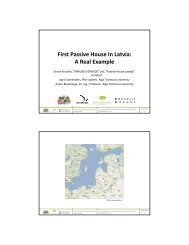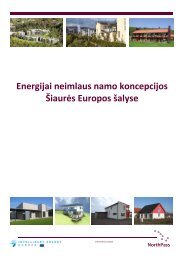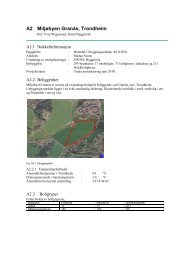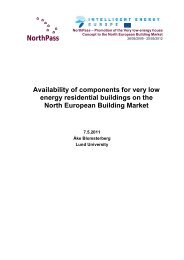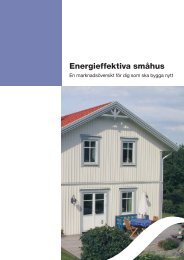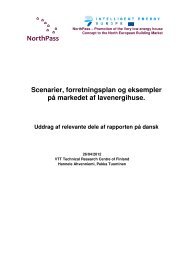Very Low-Energy House Concepts in North European ... - NorthPass
Very Low-Energy House Concepts in North European ... - NorthPass
Very Low-Energy House Concepts in North European ... - NorthPass
You also want an ePaper? Increase the reach of your titles
YUMPU automatically turns print PDFs into web optimized ePapers that Google loves.
12<br />
The quality of the air you breathe affects your comfort and by the use of a ventilation system<br />
many of the problems which can occur <strong>in</strong> standard houses can be elim<strong>in</strong>ated. First of all the<br />
system changes the air <strong>in</strong> the house with fresh air from outside when it is needed, so that the<br />
occupants never stay <strong>in</strong> air polluted by odour from persons, furniture, construction materials<br />
etc. Secondly the filters <strong>in</strong> the ventilation system will ensure that pollen etc. can not enter the<br />
<strong>in</strong>door air and thereby allergies can be reduced and at the same time the system keep the air<br />
humidity lower than 45% <strong>in</strong> the w<strong>in</strong>ter mean<strong>in</strong>g that dust mites will not thrive, both signify<strong>in</strong>g<br />
that the ventilation system can make the house healthier to live <strong>in</strong>.<br />
A comb<strong>in</strong>ation of the ventilation system and the air tight build<strong>in</strong>g envelope allows the<br />
ventilation rate to be set accord<strong>in</strong>g to the need <strong>in</strong>side and not depend<strong>in</strong>g on user <strong>in</strong>volvement<br />
or the outside w<strong>in</strong>d conditions. This means that the air can be changed often if there are many<br />
active persons <strong>in</strong> the house and less if only one sedentary person is at home, but always<br />
ensur<strong>in</strong>g that there are plenty of fresh air for whatever activity is go<strong>in</strong>g on <strong>in</strong> the build<strong>in</strong>g.<br />
Another benefit from the mechanical ventilation system which can improve the <strong>in</strong>door climate<br />
and comfort are the possibility to def<strong>in</strong>ed different ventilation rates and temperatures <strong>in</strong> each<br />
room <strong>in</strong> the build<strong>in</strong>g. In this way the <strong>in</strong>door climate can be tailored to the specific room and<br />
activity and guarantee the perfect conditions depend<strong>in</strong>g on the demands.<br />
Myth: <strong>Very</strong> low energy houses cannot breathe through the build<strong>in</strong>g envelope because it is too<br />
airtight and consequently the <strong>in</strong>door climate is bad.<br />
Fact: It is true that a build<strong>in</strong>g where the air is not changed (breath<strong>in</strong>g of the house) will have a<br />
very poor <strong>in</strong>door climate and a very low energy house is very air tight, consequently not able<br />
to breathe through the build<strong>in</strong>g envelope. The reason why the <strong>in</strong>door climate is good <strong>in</strong> a very<br />
low energy house is the ventilation system, which is an essential part of the build<strong>in</strong>g. The<br />
mechanical demand controlled ventilation system ensures the right amount of fresh air for an<br />
optimal <strong>in</strong>door climate with the lowest amount of energy used. The important difference from<br />
a standard house, where the air change is controlled by the outdoor w<strong>in</strong>d speed, the leaks <strong>in</strong><br />
the build<strong>in</strong>g envelope and user <strong>in</strong>volvement, is that <strong>in</strong> a very low energy house everyth<strong>in</strong>g can<br />
be set accord<strong>in</strong>g to the demand and controlled mechanically without the <strong>in</strong>volvement of the<br />
user. The very low energy house can not breathe by itself but with a mechanical ventilation<br />
system it can and the <strong>in</strong>door climate is at the same time controlled to fit a given situation<br />
optimum.<br />
Myth: <strong>Very</strong> low energy houses have risks of hav<strong>in</strong>g moisture problems.<br />
Fact: A leaky build<strong>in</strong>g envelope can result <strong>in</strong> moisture and mould <strong>in</strong> the construction and<br />
consequently a poor <strong>in</strong>door climate. When warm moist air can pass through leaks <strong>in</strong> the<br />
build<strong>in</strong>g envelope <strong>in</strong>to the construction it will condensate when it cools. The moist from the<br />
condensation will attach to the build<strong>in</strong>g materials and here mould can grow as well as<br />
destroy<strong>in</strong>g the construction and transmitt<strong>in</strong>g the mould to the <strong>in</strong>door climate. An airtight<br />
build<strong>in</strong>g, as the very low energy house has to be, will not experience this risk s<strong>in</strong>ce the moist<br />
will not be able to go through the build<strong>in</strong>g envelope and <strong>in</strong>to the construction.<br />
Because of the airtight build<strong>in</strong>g envelope moist problems might occur <strong>in</strong>side the very low<br />
energy house if there were no ventilation. If the air <strong>in</strong> a very airtight build<strong>in</strong>g is not changed<br />
accord<strong>in</strong>g to the demand there can be moist problem because the moist air will be trapped <strong>in</strong><br />
<strong>North</strong>Pass



